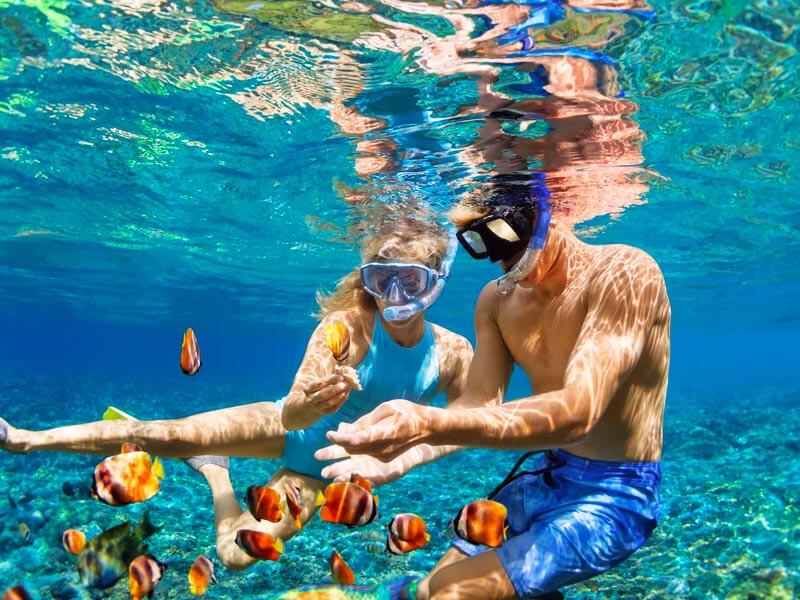
As beautiful as Sri Lanka is on land, it is equally matched with its spectacular underwater scenery. Beneath the waters of the Indian Ocean lies a separate world of tropical fish, coloured coral and mysterious shipwrecks. Located 5 to 9 degrees north of the equator means that the Sri Lanka seas are perennially warm and when in season they remain at an inviting temperature of around 27C. Sea conditions are governed by the two monsoons – the northeast and southwest- permitting calm seas and clear waters along the south and western coastline from November to April and from April to October along the eastern coast of the island. Diving and snorkeling in Sri Lanka is all the more interesting because of the different types of reef that is found in the seas around the island. There are sandstone platforms, coral banks, boulders and rock cliffs that are found both close as well as far away from the shore. Most of the reefs found on the western coast are sandstone platforms. In the Southwest and southern coast rock boulder reefs are more common as are small fringing coral reefs.
Diving Sites in Sri Lanka
Hikkaduwa – With its impressive coral reefs and abundance of tropical fish, Hikkaduwa is recognized as one of the best places for Snorkeling and diving on the Southwest coast (in the southwest season of November to April). With a reputed and long-running diving school located in the town itself, PADI diving instructors are available throughout the season for training and certification as well as leading more experienced divers in some of the country’s best ship wreck and reef dives.
Kalpitiya – Despite its natural beauty, the western peninsular area of Kalpitiya in the Puttalam district of Sri Lanka is remarkably untouched by tourism. For keen scuba divers and snorkelers, the largest coral reef in Sri Lanka (‘Bar reef’) is only an hour’s boat trip from Kalpitiya. This beautiful reef is home to an incredible variety of tropical fish as well as offering sighting of manta rays, reef sharks and the occasional turtle! Diving and Snorkeling are not possible during the southwest monsoon period (May to November). The best times are therefore between late November and early May. Transportation to dive & snorkeling sites is by a fiber glass dinghy of 25 horse power engine. For the more serious divers who want more detailed information on the area, please refer to Nautical Map 1586 (Pamban to Cape Cormorin). The underwater currents in the seas off Kalpitiya are generally not strong, but are influenced by small tide changes of two high water and two low water tides. The underwater temperature is approximately 75°F so no wetsuits are required (but thin wetsuits could be worn to protect from any bruising from the coral).
Kirinda – On the southeast coast, approximately 10km south of Tissa, lies the pretty village of Kirinda. The village itself boasts a superb beach and an interesting Buddhist shrine on the rocks. However, it is best known as a base from which to experience some excellent diving at the famous ‘Great Basses’ wreck and the Great and Little Basses reefs (southeast of Kirinda). The famous Arthur C. Clarke also put Kirinda on the map when he used it as his base for his diving exploration in order to write his book ‘The Treasure of the Reef’. A particularly unique feature of the Great Basses is the light-house that was actually constructed on the reef in 1860.
Weligama – Weligama is located approximately 30 km east of Galle. As well as having an attractive sandy bay, this fishing town is also an ideal base for snorkeling and diving, with many fascinating sites to explore. For those who\’d rather stay above the surface of the water, catamaran rides are a pleasant way to venture out on the sea. You can also go out further to the deeper waters to see a variety of dolphins and sharks. Possible Period Early November to Mid April.
Trincomalee – Trincomalee (more commonly known as ‘Trinco’) is a prime Eco tourism venue which is located on the northeast coast of Sri Lanka and offers some of the country\’s most attractive beaches such as ‘Uppuveli’ and ‘Nilaveli’. Fine white-sand and crystal clear water provides an irresistible combination that won’t fail to disappoint any visitor who loves the beach!. Snorkeling around the famous Pigeon island just off Nilaveli beach is widely recognized to be a ‘must-do’ activity during a stay in Trinco.